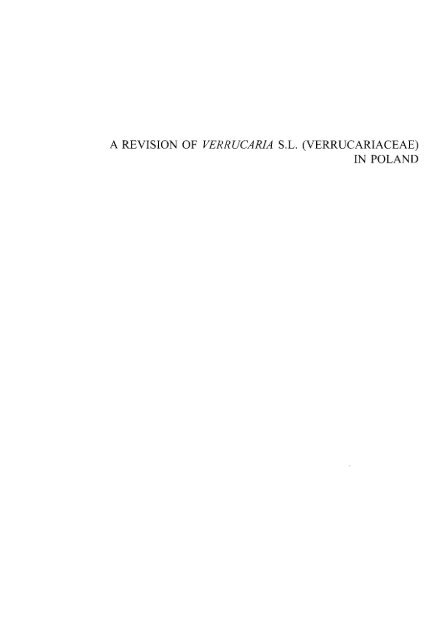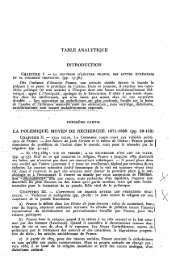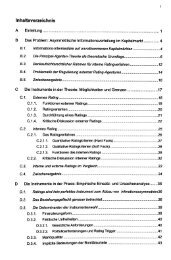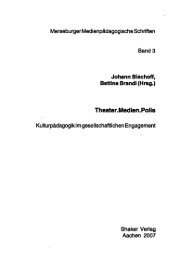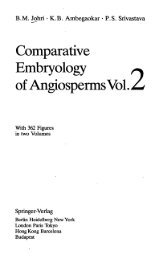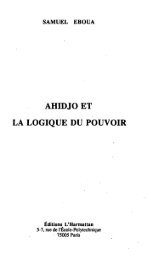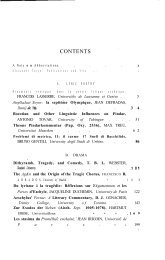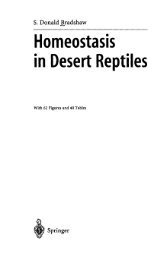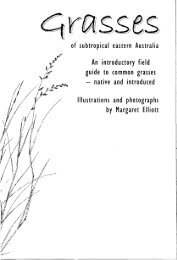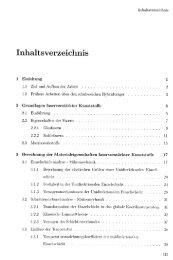a revision of verrucaria sl (verrucariaceae) in poland
a revision of verrucaria sl (verrucariaceae) in poland
a revision of verrucaria sl (verrucariaceae) in poland
You also want an ePaper? Increase the reach of your titles
YUMPU automatically turns print PDFs into web optimized ePapers that Google loves.
A REVISION OF VERRUCARIA S.L. (VERRUCARIACEAE)<br />
IN POLAND
Polish Botanical Studies 27: 3-143, 2012<br />
A REVISION OF VERRUCARIA S.L. (VERRUCARIACEAE) IN POLAND<br />
BEATA KRZEWICKA<br />
Abstract. A taxonomic treatment <strong>of</strong> the genus Verrucaria s.l. <strong>in</strong> Poland is provided, based on a study <strong>of</strong> ca 1700 specimens<br />
from Polish and foreign herbaria. A total <strong>of</strong> 62 species belong<strong>in</strong>g to seven genera currently separated with<strong>in</strong> Verrucaria s.l. are<br />
presented <strong>in</strong>clud<strong>in</strong>g two new comb<strong>in</strong>ations, Verniculopsis m<strong>in</strong>utiim (Hepp) Krzewicka and Parabagliettoa disjuncta (Arnold)<br />
Krzewicka. The follow<strong>in</strong>g genera and species are recognized <strong>in</strong> the study area: Bagliettoa - B. baldensis (A. Massal.) Vezda,<br />
B. calciseda (DC.) Gueidan & Cl. Roux, B. marmorea (Scop.) Gueidan & Cl. Roux, B. parmigerella (Zahlbr.) Vezda & Poelt;<br />
Hydropunctaria - H. maura (Wahlenb.) Keller, Gueidan & Thus, //. rheitrophila (Zschacke) Keller, Gueidan & Thus, H. scabra<br />
(Vezda) Keller, Gueidan & Thus; Parabagliettoa - P. cyanea (A. Massal.) Gueidan & Cl. Roux, P. disjuncta, P. dufourii (DC.)<br />
Gueidan & Cl. Roux; Placopyrenium - P. canellum (Nyl.) Gueidan & Cl. Roux, P. fuscellum (Turner) Gueidan & Cl. Roux,<br />
P. trachyticum (Haz<strong>sl</strong>.) Breuss; Verrucaria - V. acrotella auct., V amylacea Hepp, V. andesiatica Servit, V. aquatilis Mudd,<br />
V. bryoctona (Th.Fr.) Orange, V. caerulea DC, V. cataleptoides (Nyl.) Nyl., V. cernaensis Zschacke, V. c<strong>in</strong>cta Hepp, V. denudata<br />
Zschacke, V. dolosa Hepp, V. elae<strong>in</strong>a Borrer, V. elaeomelaena (A. Massal.) Arnold, V.funckii (Spreng.) Zahlbr., V. hochstetteri<br />
Fr., V. latebrosa KSrb., V. macrostoma DC, V. maculiformis KrL-<strong>in</strong>p., V. madida Orange, V. margacea (Wahlenb.) Wahlenb.,<br />
V. muralis Ach., V. myriocarpa Hepp, V. nigrescens Pers., V. nigroumbr<strong>in</strong>a (A. Massal.) Servit, V. obfuscans (Nyl.) Nyl., V. ochrostoma<br />
Borrer, V. pachyderma (Arnold) Arnold, V. p<strong>in</strong>guicula A. Massal., V. policensis Servit, V. polonica J. Nowak, V.polysticta<br />
Borrer, V. praetermissa (Trevisan) Anzi, V. procopii Servit, V. sphacrospora Anzi, V. sublobulata Servit, V. submauroides auct.,<br />
V. submersella Servit, V. tecwrum (A. Massal.) Korb., V. tristis (A. Massal.) Kremp., V. umbhnula Nyl., V. viridicans Servit,<br />
V. viridula (Schrad.) Ach., V. xyloxena Norman; Verrucula - V. elegantaria (Zehetl.) Nav.-Ros. & Cl. Roux, V. helvetica (B. de<br />
Lesd.) Nav.-Ros. & Cl. Roux, V. polycarparia Nav.-Ros. & Cl. Roux, V. protearia (Zehetl.) Nav.-Ros. & Cl. Roux; and Verruculopsis<br />
- V. lecideoides (A. Massal.) Gueidan & Cl. Roux, V. m<strong>in</strong>utum. Three species, Parabagliettoa disjuncta, Verrucula<br />
elegantaria and V.polycarparia are reported for the first time from Poland. Twenty five taxa are excluded from the survey because<br />
they were mistakenly reported or not confirmed for the study area. I he morphology, anatomy, ecology and known distribution <strong>of</strong><br />
all treated taxa are discussed. Keys for the identification <strong>of</strong> genera and particular groups <strong>of</strong> the species are provided. Additional<br />
nomenclatural and taxonomic clarification <strong>in</strong>clude the typification <strong>of</strong> Thrombium lecideoides A. Massal., Verrucaria aquatilis<br />
var. aerimontana Servit and Verrucaria timkoii Servit, and the synonymy <strong>of</strong> Lithoicea nigrescens var. acrotella A. Massal. with<br />
Verrucaria nigrescens, Verrucaria amylacea f. compacta Arnold with Verrucaria amylacea, Verrucaria aquatilis var. aerimontana<br />
with Verrucaria aquatilis, Verrucaria atroviridis Servit with Verrucaria aquatilis, Verrucaria denudata f. dissulta Servit with<br />
Verrucaria funckii, Verrucaria elae<strong>in</strong>a var. determ<strong>in</strong>ata Korb. with Verrucaria praetermissa, Verrucaria elae<strong>in</strong>a var. effusa Korb.<br />
with Verrucaria submersella, Verrucaria h<strong>of</strong>fmanni Hepp with Bagliettoa marmorea, Verrucaria maura var. opaca Korb. with<br />
Hydropunctaria scabra, Verrucaria nigr<strong>of</strong>usca Servit with Verrucaria nigroumbr<strong>in</strong>a, Verrucaria sublobulata var. robustior Servit<br />
with Verrucaria sublobulata, Verrucaria timkoii with Bagliettoa calciseda. The name Verrucaria funckiana is rejected because<br />
it proved illegitimate as it was nomenclaturally superfluous when published.<br />
Key words: Verucariaceae, Bagliettoa, Hydropunctaria, Parabagliettoa, Placopyrenium, Verrucaria, Verrucula, Verruculopsis,<br />
<strong>revision</strong>, nomenclature, taxonomy, ecology, key, Poland<br />
Beata Krzewicka, W. Szafer Institute <strong>of</strong> Botany, Polish Academy oj Sciences, Lubicz 46, 31-512 Krakow, Poland, e-mail:<br />
b. krzewicka@botany.pl<br />
CONTENTS<br />
INTRODUCTION 4 THE GENUS BAGLIETTOA 10<br />
SYSTEMATIC BACKGROUND 5 KEY TO THE SPECIES 11<br />
MATERIAL AND METHODS 7 . B. baldensis 12<br />
RESULTS 8 B. calciseda 14<br />
KEY TO GENERA 9 5. marmorea 16<br />
KEY TO THE PARASITIC SPECIES 10 B. parmigerella 18
THE GENUS HYDROPUNCTARIA 19<br />
KEY TO THE SPECIES 20<br />
H. maura 20<br />
H. rheitrophila 22<br />
H. scabra 24<br />
THE GENUS PARABAGLIETTOA 26<br />
KEY TO THE SPECIES 27<br />
P. cyanea 27<br />
P. disjuncta 28<br />
P. diifourii 29<br />
THE GENUS PLACOPYRENIUM 31<br />
KEY TO THE SPECIES 32<br />
P. canellum 32<br />
P. fuscellum 33<br />
P. trachyticum 35<br />
THE GENUS VERRUCARIA 36<br />
KEY TO THE SPECIES 38<br />
V. acrotella 41<br />
V. amylacea 42<br />
V. andesiatica 43<br />
V. aquatilis 44<br />
V. bryoctona 48<br />
V. caenilea 49<br />
V. cataleptoides 51<br />
V. cernaensis 52<br />
V. c<strong>in</strong>cta 54<br />
V. denudata 55<br />
V. dolosa 58<br />
V. elae<strong>in</strong>a 59<br />
V. elaeomelaena 61<br />
V.funckii 62<br />
V. hochstetteri 64<br />
V. latebrosa 66<br />
V. macrostoma 68<br />
V. maculiformis 70<br />
V. madida 72<br />
V. margacea 73<br />
V. mural is 75<br />
INTRODUCTION<br />
The concept <strong>of</strong>' Verrucaria s.l.' used here <strong>in</strong>cludes<br />
pyrenocarpous crustose, areolate or placodioid species<br />
with heteromerous thalli <strong>of</strong> a variable degree <strong>of</strong><br />
differentiation, and various types <strong>of</strong> upper cortex,<br />
an algal layer and a medulla. The perithecia are<br />
immersed or superficial, with or without <strong>in</strong>volucrellum,<br />
the hamathecium comprises periphyses<br />
POLISH BOTANICAL STUDIES 27. 2012<br />
V. myriocarpa 78<br />
V. nigrescens 79<br />
V. nigroumbr<strong>in</strong>a 81<br />
V. obfuscans 82<br />
V. ochrostoma 84<br />
V. pachyderma 84<br />
V. p<strong>in</strong>guicula 86<br />
V. policensis 87<br />
V. polonica 88<br />
V. polysticta 89<br />
V. praetermissa 90<br />
V. procopii 93<br />
V. sphaerospora 94<br />
V. sublobulata 96<br />
( /- . submauroides 97<br />
V. submersella 98<br />
V. tectorum 100<br />
V. tristis 101<br />
V. umbr<strong>in</strong>ula 102<br />
V. viridicans 103<br />
V. viridula 104<br />
V. xyloxena 105<br />
THE GENUS VERRUCULA 106<br />
KEY TO THE SPECIES 108<br />
V. elegantaria 108<br />
V. helvetica 109<br />
V. polycarparia<br />
V. pro tearia . . .<br />
THE GENUS VERRUCULOPSIS .<br />
KEY TO THE SPECIES<br />
V. lecideoides<br />
V. m<strong>in</strong>utum<br />
11<br />
12<br />
13<br />
14<br />
14<br />
115<br />
EXCLUDED TAXA 117<br />
SUMMARY 122<br />
ACKNOWLEDGEMENTS 124<br />
REFERENCES 124<br />
CHECKLIST 133<br />
INDEX TO SCIENTIFIC NAMES 139<br />
and periphysoids, with no paraphyses, and the ascospores<br />
are simple and colourless. The members<br />
<strong>of</strong> Verrucaria s.l. occur mostly directly on calcareous<br />
or siliceous rocks. They rarely live as parasites<br />
on other lichens grow<strong>in</strong>g on rocks and they are<br />
found occasionally on soil or bark. They can grow<br />
<strong>in</strong> terrestrial, freshwater or maritime habitats.<br />
In Poland the history <strong>of</strong> lichenological data<br />
concern<strong>in</strong>g Verrucaria species spans a period <strong>of</strong>


